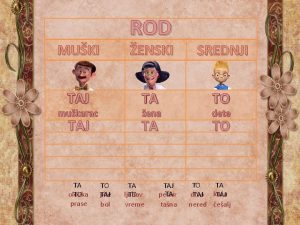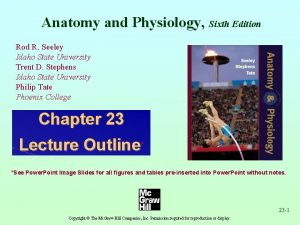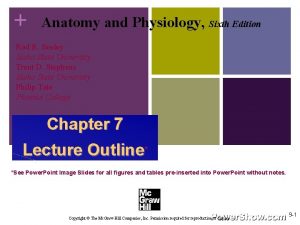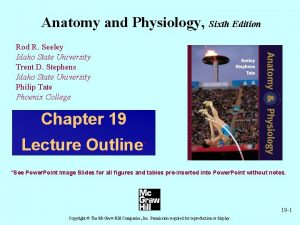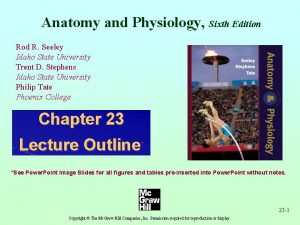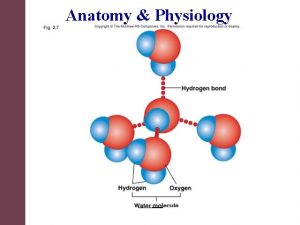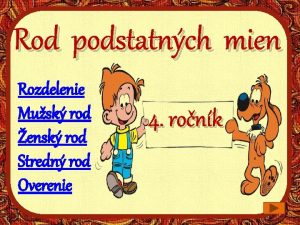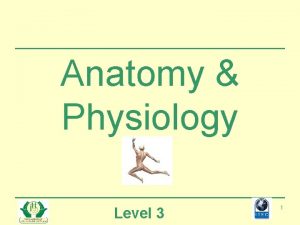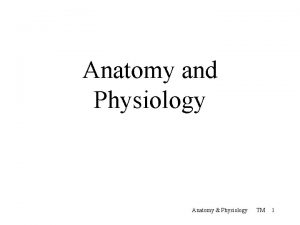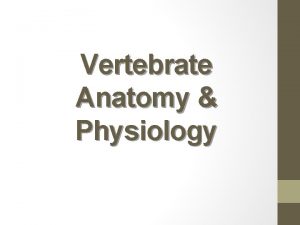Anatomy and Physiology Sixth Edition Rod R Seeley















































- Slides: 47

Anatomy and Physiology, Sixth Edition Rod R. Seeley Idaho State University Trent D. Stephens Idaho State University Philip Tate Phoenix College Chapter 24 Lecture Outline* *See Power. Point Image Slides for all figures and tables pre-inserted into Power. Point without notes. 1 Copyright © The Mc. Graw-Hill Companies, Inc. Permission required for reproduction or display.

Chapter 24 Digestive System 2

Digestive System Anatomy • Digestive tract – Alimentary tract or canal – GI tract • Accessory organs – Primarily glands • Regions – – – – Mouth or oral cavity Pharynx Esophagus Stomach Small intestine Large intestine Anus 3

Functions • Ingestion: Introduction of food into stomach • Mastication: Chewing • Propulsion – Deglutition: Swallowing – Peristalsis: Moves material through digestive tract 4

Functions • • • Mixing: Segmental contraction that occurs in small intestine Secretion: Lubricate, liquefy, digest Digestion: Mechanical and chemical Absorption: Movement from tract into circulation or lymph Elimination: Waste products removed from body 5

Digestive Tract Histology 6

Digestive System Regulation • Nervous regulation – Involves enteric nervous system • Types of neurons: sensory, motor, interneurons – Coordinates peristalsis and regulates local reflexes • Chemical regulation – Production of hormones • Gastrin, secretin – Production of paracrine chemicals • Histamine • Help local reflexes in ENS control digestive environments as p. H levels 7

Peritoneum and Mesenteries • Peritoneum – Visceral: Covers organs – Parietal: Covers interior surface of body wall – Retroperitoneal: Behind peritoneum as kidneys, pancreas, duodenum • Mesenteries – Routes which vessels and nerves pass from body wall to organs – Greater omentum – Lesser omentum 8

Oral Cavity • Mouth or oral cavity – Vestibule: Space between lips or cheeks and alveolar processes – Oral cavity proper • Lips (labia) and cheeks • Palate: Oral cavity roof – Hard and soft • Palatine tonsils • Tongue: Involved in speech, taste, mastication, swallowing 9

Teeth • Two sets – Primary, deciduous, milk: Childhood – Permanent or secondary: Adult (32) • Types – Incisors, canine, premolar and molars 10

Teeth 11

Salivary Glands • Produce saliva – Prevents bacterial infection – Lubrication – Contains salivary amylase • Breaks down starch • Three pairs – Parotid: Largest – Submandibular – Sublingual: Smallest 12

Pharynx and Esophagus • Pharynx – Nasopharynx – Oropharynx: Transmits food normally – Laryngopharynx: Transmits food normally – Transports food from pharynx to stomach – Passes through esophageal hiatus (opening) of diaphragm and ends at stomach • Hiatal hernia – Sphincters • Upper • Lower 13

Deglutition (Swallowing) • Three phases – Voluntary • Bolus of food moved by tongue from oral cavity to pharynx – Pharyngeal Reflex: Upper esophageal sphincter relaxes, elevated pharynx opens the esophagus, food pushed into esophagus – Esophageal • Reflex: Epiglottis is tipped posteriorly, larynx elevated to prevent food from passing into larynx 14

Phases of Deglutition (Swallowing) 15

Stomach Anatomy • Openings – Gastroesophageal: To esophagus – Pyloric: To duodenum • Regions – – Cardiac Fundus Body Pyloric 16

17

Stomach Histology • Layers – Serosa or visceral peritoneum: Outermost – Muscularis: Three layers • Outer longitudinal • Middle circular • Inner oblique – Submucosa – Mucosa 18

Stomach Histology • Rugae: Folds in stomach when empty • Gastric pits: Openings for gastric glands – Contain cells • Surface mucous: Mucus • Mucous neck: Mucus • Parietal: Hydrochloric acid and intrinsic factor • Chief: Pepsinogen • Endocrine: Regulatory hormones 19

Hydrochloric Acid Production 20

Phases of Gastric Secretion 21

Movements in Stomach 22

Small Intestine • Site of greatest amount of digestion and absorption • Divisions – Duodenum – Jejunum – Ileum: Peyer’s patches or lymph nodules • Modifications – Circular folds or plicae circulares, villi, lacteal, microvilli • Cells of mucosa – Absorptive, goblet, granular, endocrine 23

Small Intestine Secretions • Mucus – Protects against digestive enzymes and stomach acids • Digestive enzymes – Disaccharidases: Break down disaccharides to monosaccharides – Peptidases: Hydrolyze peptide bonds – Nucleases: Break down nucleic acids • Duodenal glands – Stimulated by vagus nerve, secretin, chemical or tactile irritation of duodenal mucosa 24

Duodenum and Pancreas 25

Duodenum Anatomy and Histology 26

Liver • Lobes – Major: Left and right – Minor: Caudate and quadrate • Ducts – Common hepatic – Cystic • From gallbladder – Common bile • Joins pancreatic duct at hepatopancreatic ampulla 27

Functions of the Liver • Bile production – Salts emulsify fats, contain pigments as bilirubin • Storage – Glycogen, fat, vitamins, copper and iron • Nutrient interconversion • Detoxification – Hepatocytes remove ammonia and convert to urea • Phagocytosis – Kupffer cells phagocytize worn-out and dying red and white blood cells, some bacteria • Synthesis – Albumins, fibrinogen, globulins, heparin, clotting factors 28

Blood and Bile Flow 29

Duct System 30

Gallbladder • Bile is stored and concentrated • Stimulated by cholecystokinin and vegal stimulation • Dumps into small intestine • Production of gallstones possible – Drastic dieting with rapid weight loss 31

Pancreas • Anatomy – Endocrine • Pancreatic islets produce insulin and glucagon – Exocrine • Acini produce digestive enzymes – Regions: Head, body, tail • Secretions – Pancreatic juice (exocrine) • • • Trypsin Chymotrypsin Carboxypeptidase Pancreatic amylase Pancreatic lipases Enzymes that reduce DNA and ribonucleic acid 32

Bicarbonate Ion Production 33

Pancreatic Secretion Control 34

Large Intestine • Extends from ileocecal junction to anus • Consists of cecum, colon, rectum, anal canal • Movements sluggish (18 -24 hours) 35

Large Intestine • Cecum – Blind sac, vermiform appendix attached • Colon – Ascending, transverse, descending, sigmoid • Rectum – Straight muscular tube • Anal canal – Internal anal sphincter (smooth muscle) – External anal sphincter (skeletal muscle) – Hemorrhoids: Vein enlargement or inflammation 36

Secretions of Large Intestine • Mucus provides protection – Parasympathetic stimulation increases rate of goblet cell secretion • Pumps – Exchange of bicarbonate ions for chloride ions – Exchange of sodium ions for hydrogen ions • Bacterial actions produce gases called flatus 37

Histology of Large Intestine 38

Movement in Large Intestine • Mass movements – Common after meals • Local reflexes in enteric plexus – Gastrocolic: Initiated by stomach – Duodenocolic: Initiated by duodenum • Defecation reflex – Distension of the rectal wall by feces • Defecation – Usually accompanied by voluntary movements to expel feces through abdominal cavity pressure caused by inspiration 39

Reflexes in Colon and Rectum 40

Digestion, Absorption, Transport • Digestion – Breakdown of food molecules for absorption into circulation • Mechanical: Breaks large food particles to small • Chemical: Breaking of covalent bonds by digestive enzymes • Absorption and transport – Molecules are moved out of digestive tract and into circulation for distribution throughout body 41

Carbohydrates • Consist of starches, glycogen, sucrose, lactose, glucose, fructose • Polysaccharides broken down to monosaccharides • Monosaccharides taken up by active transport or facilitated diffusion and carried to liver • Glucose is transported to cells requiring energy – Insulin influences rate of transport 42

Lipids • Include triglycerides, phospholipids, steroids, fat-soluble vitamins • Emulsification breaks down large lipid droplets to small 43

Lipoproteins • Types – Chylomicrons • Enter lymph – VLDL – LDL • Transports cholesterol to cells – HDL • Transports cholesterol from cells to liver 44

Proteins • Pepsin breaks proteins into smaller polypeptide chains • Proteolytic enzymes produce small peptide chains – Dipeptides, tripeptides, amino acids 45

Water and Ions • Water – Can move in either direction across wall of small intestine depending on osmotic gradients • Ions – Sodium, potassium, calcium, magnesium, phosphate are actively transported 46

Effects of Aging • Decrease in mucus layer, connective tissue, muscles and secretions • Increased susceptibility to infections and toxic agents – Ulcerations and cancers 47
 Taj ta to
Taj ta to Human anatomy and physiology seventh edition marieb
Human anatomy and physiology seventh edition marieb Anatomy and physiology edition 9
Anatomy and physiology edition 9 Paratubular cyst
Paratubular cyst Peter pickle tongue twister
Peter pickle tongue twister The sixth sick sheik's sixth sheep's sick lyrics
The sixth sick sheik's sixth sheep's sick lyrics Biochemistry sixth edition
Biochemistry sixth edition Computer architecture a quantitative approach sixth edition
Computer architecture a quantitative approach sixth edition Automotive technology sixth edition
Automotive technology sixth edition Automotive technology sixth edition
Automotive technology sixth edition Apa sixth edition
Apa sixth edition Computer architecture a quantitative approach 6th
Computer architecture a quantitative approach 6th Precalculus sixth edition
Precalculus sixth edition Rational people think at the margin
Rational people think at the margin Computer architecture a quantitative approach sixth edition
Computer architecture a quantitative approach sixth edition Physiology of sport and exercise 5th edition
Physiology of sport and exercise 5th edition Parts of the upper respiratory tract
Parts of the upper respiratory tract Tattoo anatomy and physiology
Tattoo anatomy and physiology International anatomy olympiad
International anatomy olympiad Incomplete flower
Incomplete flower Bone metabolism
Bone metabolism Duodenal ulcer anatomy
Duodenal ulcer anatomy Liver physiology and anatomy
Liver physiology and anatomy Difference between anatomy and physiology
Difference between anatomy and physiology Epigastric region
Epigastric region Google.com
Google.com Chapter 14 anatomy and physiology
Chapter 14 anatomy and physiology Http://anatomy and physiology
Http://anatomy and physiology Waistline
Waistline Anatomy and physiology of appendix
Anatomy and physiology of appendix Aohs foundations of anatomy and physiology 1
Aohs foundations of anatomy and physiology 1 Aohs foundations of anatomy and physiology 2
Aohs foundations of anatomy and physiology 2 Anatomy and physiology of swine
Anatomy and physiology of swine Anatomy and physiology chapter 8 special senses
Anatomy and physiology chapter 8 special senses Chapter 13 anatomy and physiology of pregnancy
Chapter 13 anatomy and physiology of pregnancy Agriscience unit 26 self evaluation answers
Agriscience unit 26 self evaluation answers Science olympiad anatomy and physiology 2020 cheat sheet
Science olympiad anatomy and physiology 2020 cheat sheet Chapter 2 basic chemistry anatomy and physiology
Chapter 2 basic chemistry anatomy and physiology Gastric emptying ppt
Gastric emptying ppt Anatomy and physiology of diabetes
Anatomy and physiology of diabetes Anatomy and physiology chapter 7
Anatomy and physiology chapter 7 Anatomy and physiology coloring workbook figure 14-1
Anatomy and physiology coloring workbook figure 14-1 Chapter 10 blood anatomy and physiology
Chapter 10 blood anatomy and physiology Aohs foundations of anatomy and physiology 1
Aohs foundations of anatomy and physiology 1 Aohs foundations of anatomy and physiology 1
Aohs foundations of anatomy and physiology 1 Anatomy and physiology
Anatomy and physiology Anatomy and physiology chapter 15
Anatomy and physiology chapter 15 Cornell notes for anatomy and physiology
Cornell notes for anatomy and physiology
